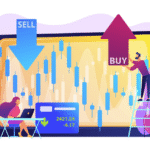Decoding Online Trading Terminologies and Jargons
When stepping into the world of online trading, it is easy to get overwhelmed by the vast array of terminologies and jargon used in the industry. However, understanding these terms is essential for navigating the financial markets effectively. Let us break down some of the most common online trading terminologies to help you trade with confidence.

MOST COMMON JARGONS IN ONLINE TRADING
- Pip (Percentage in Point)
A pip is one of the most common online trading terminologies. It refers to the smallest price movement in currency trading, usually representing 0.0001 of a currency pair. For example, if the EUR/USD moves from 1.1050 to 1.1051, that’s a 1 pip movement. Understanding pip movements is crucial in measuring profit or loss in forex trading.
- Spread
The spread refers to the difference between the buy (ask) and sell (bid) price of a trading asset. It’s essentially the cost you pay to execute a trade. A tighter spread means a lower trading cost, while a wider spread can indicate less liquidity or more volatility in the market.
- Leverage
Leverage allows traders to control a large position with a relatively small amount of capital. For instance, with a leverage of 100:1, you can control a $10,000 trade with only $100 in your account. While leverage amplifies potential profits, it also increases the risk of significant losses, so it must be used carefully.
- Margin
A trader must have a minimum amount of capital in their account to open and maintain a leveraged position, known as the margin. For example, if you have a leverage of 100:1, you only need 1% of the total value of the trade to open a position. Proper margin management is crucial to avoid margin calls or account liquidation.
- Bull Market vs. Bear Market
These two terms describe overall market conditions. A bull market is when prices are generally rising, indicating optimism and confidence among traders. In contrast, a bear market is when prices are falling, often signaling pessimism and fear. Understanding these market trends helps traders align their strategies accordingly.
- Bid and Ask Price
The bid price is the highest price a buyer is willing to pay for an asset, while the ask price is the lowest price a seller is willing to accept. Traders refer to the difference between the bid and ask prices as the spread. Knowing how these prices work allows traders to time their entry and exit points more effectively.
- Stop-Loss Order
Traders use a stop-loss order as a risk management tool to automatically close a trade once the asset reaches a specified price. This helps traders limit their potential losses in case the market moves against their position. It’s a key part of a disciplined trading strategy, especially in volatile markets.
- Take Profit Order
Traders use a take-profit order to automatically close a trade when the asset reaches a predetermined profit level. This ensures that you lock in gains before the market can reverse. Combining take-profit and stop-loss orders is a common strategy to manage risk and reward effectively.
- Liquidity
Liquidity refers to how easily an asset can be bought or sold without significantly affecting its price. Highly liquid markets, like forex, tend to have tighter spreads and more predictable price movements. Low liquidity, on the other hand, can lead to price gaps and higher volatility, making it riskier for traders.
- Volatility
Volatility measures the degree of price movement in a market or asset over a period of time. A highly volatile asset has large and frequent price swings, while a less volatile one has more stable movements. Volatility is a double-edged sword because while it creates opportunities for profit, it also increases risk.
- Candlestick Chart
Traders widely use candlestick charts to analyze price movements. Each “candle” represents the price action of an asset over a specific time frame (e.g., 1 minute, 1 hour, 1 day). Candlesticks show the opening, closing, high, and low prices of an asset, providing valuable insights into market sentiment.
- Slippage
Fast-moving markets can cause slippage, leading to trades being executed at a different price than expected. It can happen during high volatility or low liquidity and can result in traders getting a worse price than anticipated. Understanding slippage helps traders set realistic expectations, especially during major news events.
- Requote
In trading, brokers issue a requote when the price changes after a trader submits an initial request. This typically happens in fast-moving markets where the price of an asset can change rapidly.
ALWAYS REMEMBER:
Online trading comes with its language, but once you familiarize yourself with the basic online trading terminologies, you’ll be better equipped to navigate the markets confidently. Whether you’re analyzing charts, placing orders, or managing your risk, knowing these key trading terms will help you make more informed decisions and enhance your overall trading experience. Understanding trading jargon is the first step toward becoming a knowledgeable and successful trader. So, the next time you hear about spreads, margins, or candlestick charts, you’ll know exactly what they mean and how they impact your trades.

What is Lorem Ipsum?
Lorem Ipsum is simply dummy text of the printing and typesetting industry. Lorem Ipsum has been the industry’s standard dummy text ever since the 1500s,
How to Read Forex Charts Like a Pro
How to Read Forex Charts Like a Pro Forex charts are the foundation of every trader’s decision-making process. These charts visually display currency price movements

CFD Trading Explained: What It Is and How It Works
CFD Trading Explained: What It Is and How It Works Contracts for Difference, more commonly known as CFD Trading, represent a modern way of engaging
SmarTrade Featured in Manila Standard for Bringing Back Exclusive Trading Seminar to Manila
SmarTrade Featured in Manila Standard for Bringing Back Exclusive Trading Seminar to Manila SmarTrade has once again proven its leadership in financial education as it

Forex Broker: How to Choose the Right One
Choose the right Forex broker for your trading journey with essential tips and insights to enhance your trading experience and success.

Emotional Trading: How to Stay Calm and Collected
Discover the impact of emotional trading and learn strategies to maintain calmness and clarity in your trading decisions.
